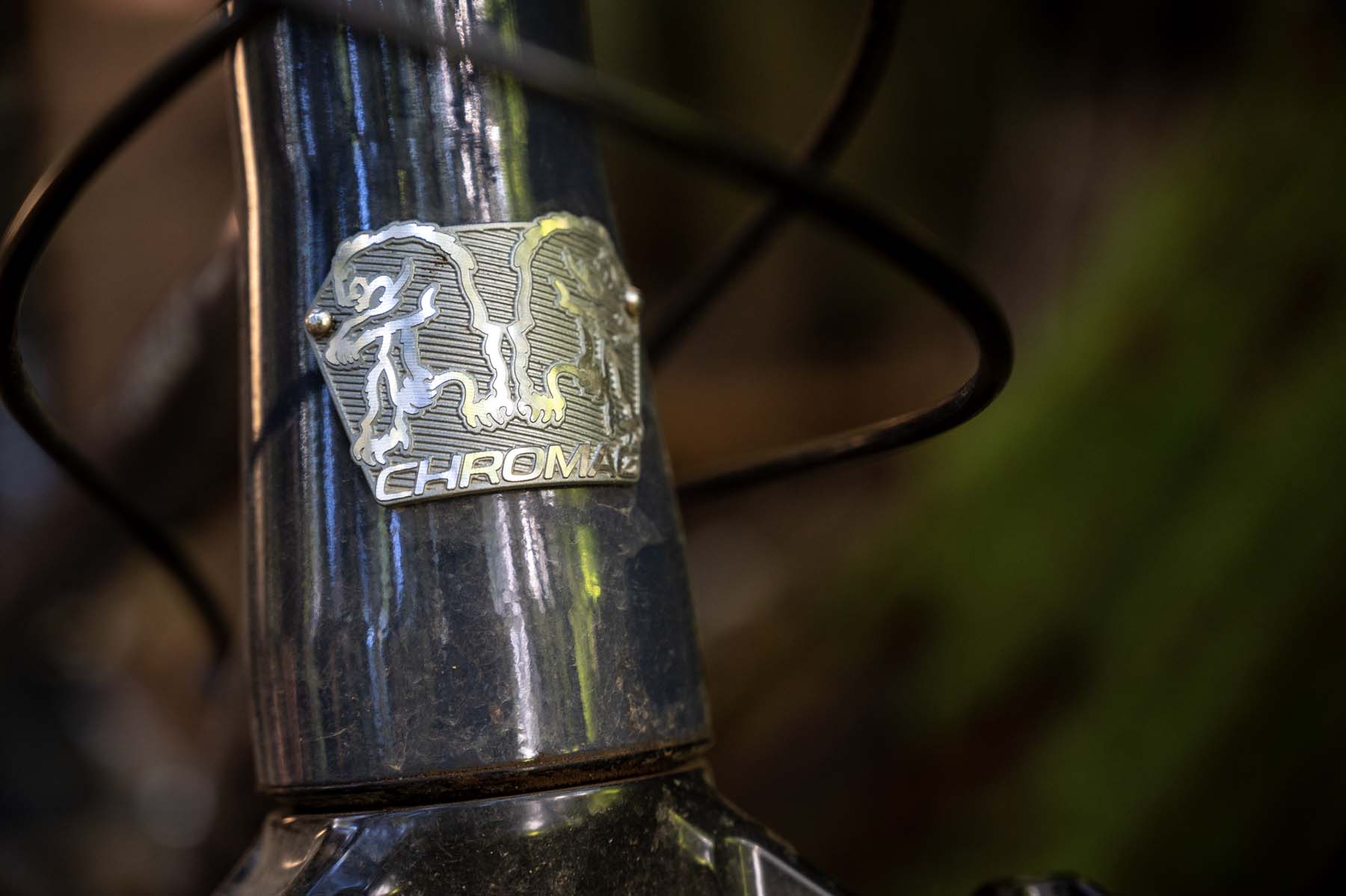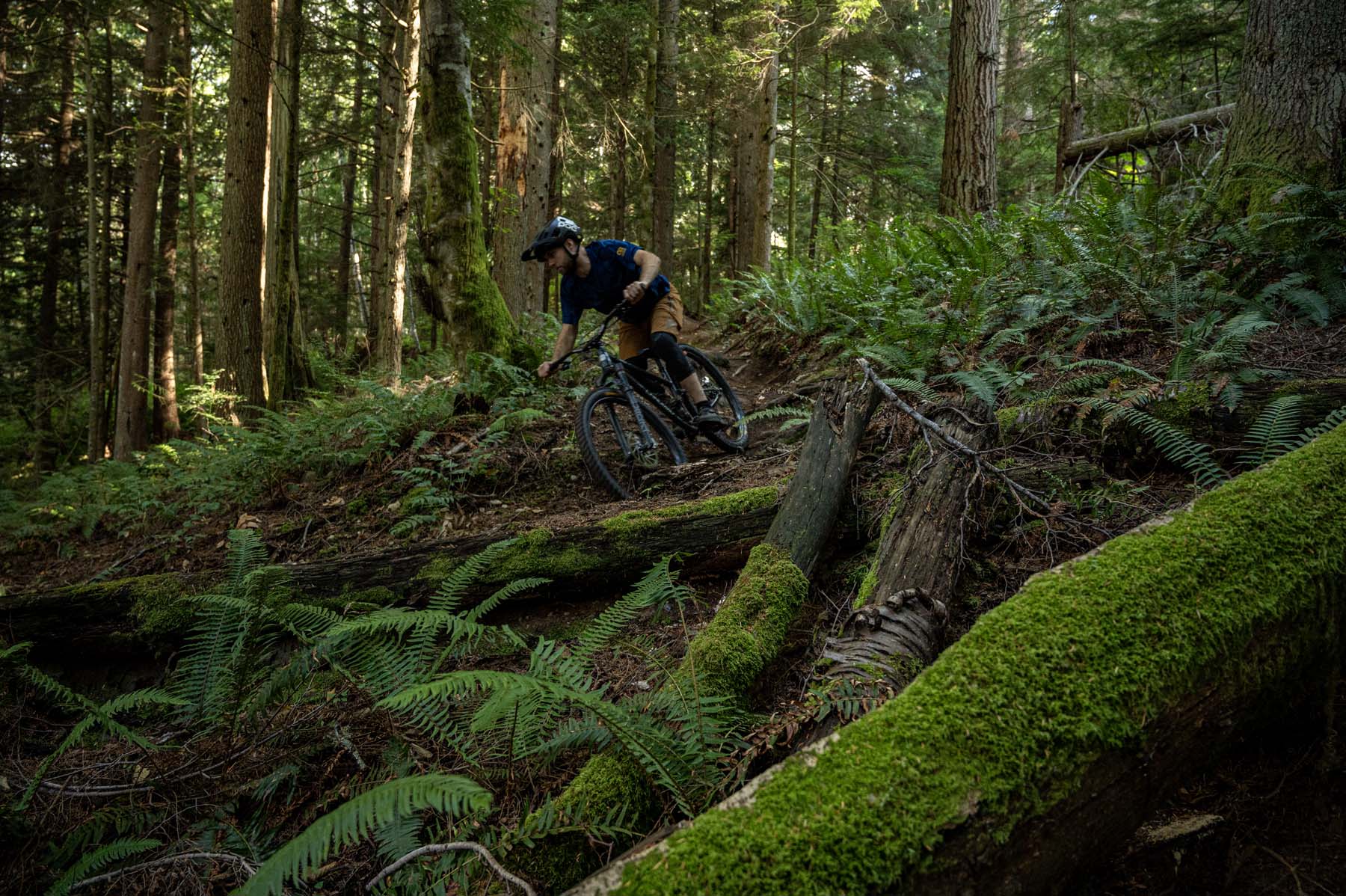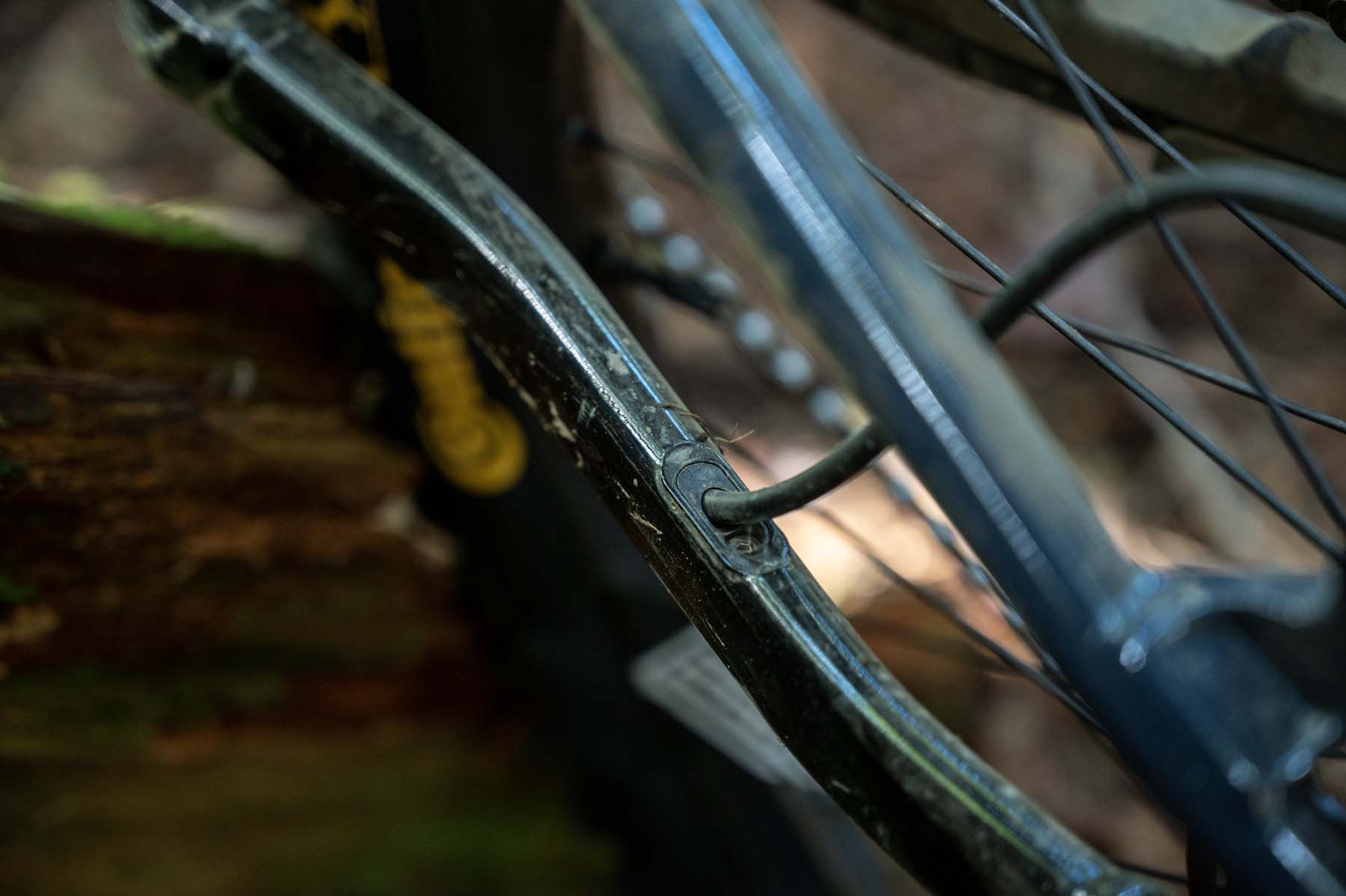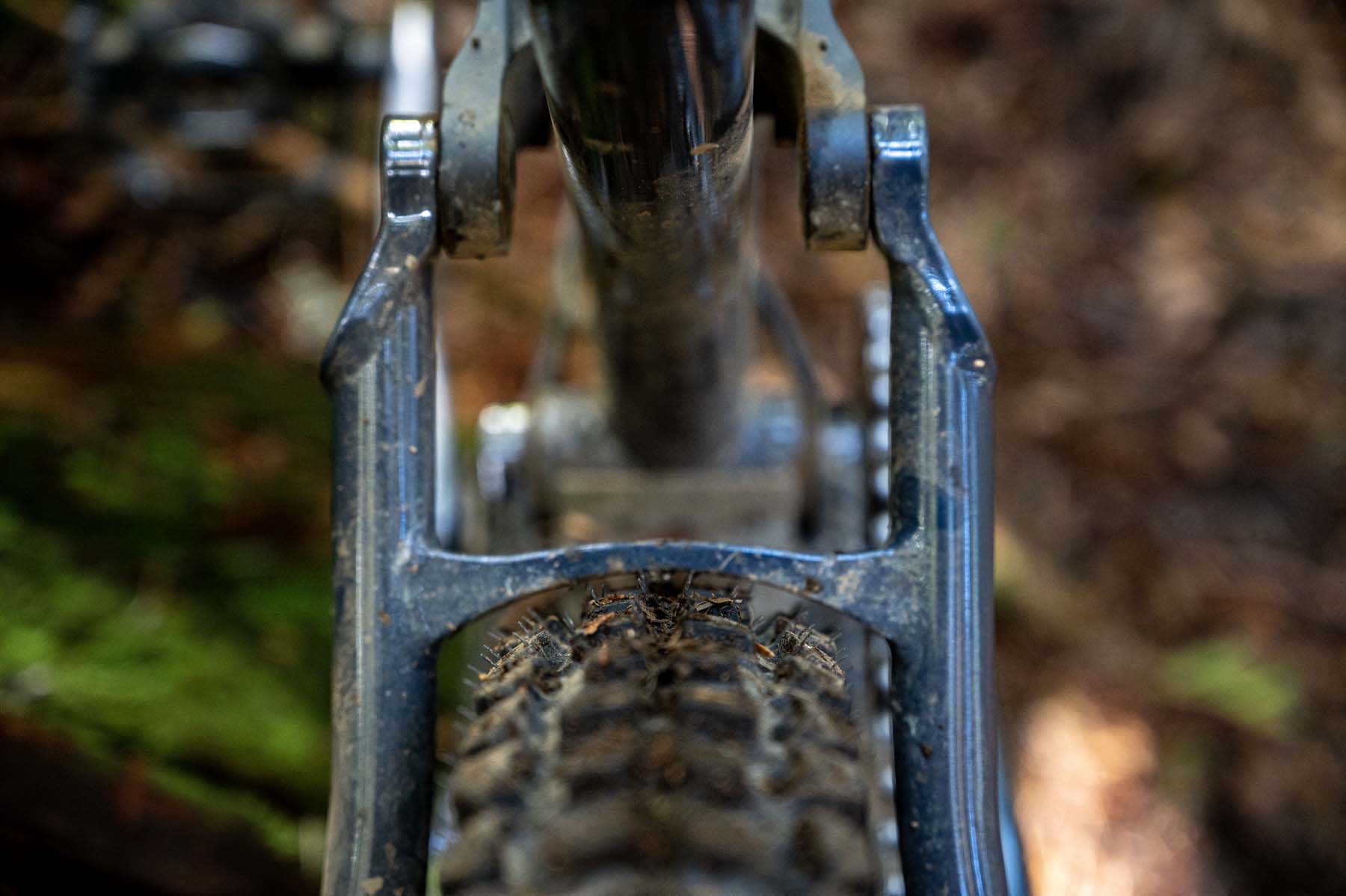Chromag Darco
Wheel Size: 29’’
Travel: 120 mm rear / 150 mm front
Geometry Highlights:
- Sizes offered: S, M, M/L, L, XL
- Headtube angle: 64°
- Seat tube angle: 78°
- Reach: 490 mm (size M/L)
- Chainstay length: 435 mm
Frame Material: Steel and titanium front triangle options; aluminum chainstay / steel seatstay
Price:
- Darco Frame: $3,450 USD
- Darco Ti Frame: $4,900 USD
- Darco: $5,857 USD
- Darco Ti: $8,885 USD
Blister’s Measured Weight: 34.4 lb / 15.6 kg (Darco, size M/L)
Test Duration: 2.5 months
Test Locations: Washington, British Columbia
Reviewer: 6′, 175 lb / 183 cm, 77.1 kg

Intro
I really didn’t know what to expect from the Darco going into this review. For one thing, it’s Chromag’s first production (adult) full-suspension bike, so there’s not much of a track record to look to. It’s also a short-travel bike with notably aggressive geometry, a much longer-travel fork (150 mm) than most bikes with just 120 mm of travel to work with in back, and some pretty out-there recommended sizing. And then it’s (mostly) made of steel to boot.
After a few months on it, I can now say the Darco is one of the most unusual bikes I’ve been on in a long time — and one I genuinely had more fun on than most — but it’s also got some quirks. It’s not a bike for everyone, but that also has the potential to make it an especially good option for the right folks. And if it happens to be what you’re looking for, I’ve yet to try anything else quite like it.
[For all the info on the specs and geometry of the Darco, check out our First Look on it and its longer-travel sibling, the Lowdown.]

Fit & Sizing
At 6’ / 183 cm tall, I’m right in the overlapping region on Chromag’s recommended size chart between the M/L and Large Darco frames, which is not a common place for me to be — I’m more typically getting on Large frames, or occasionally an XL. But the 514 mm reach on the Large Darco sounded daunting, especially on a shorter-travel bike that (I imagined) I’d want to try to keep a bit more nimble, rather than trying to fully maximize stability. And of course, comparing nominal sizes across brands (or even models) of bikes isn’t terribly meaningful in a lot of cases, too. So I opted for the M/L Darco, and though my thinking on the fit and sizing went through a bit of an evolution over the course of my time on the bike, I ultimately think that was the right call.

My first impression when hopping aboard the Darco — on some steep and unfamiliar trails on its home turf in Whistler — was that the sizing definitely did not feel as big as the M/L’s 490 mm reach might suggest. The steep seat tube and the resulting short (for the reach) 622 mm effective top tube are definitely part of the story there, but I think the short stack height is a bigger one. For one thing, I’d promptly maxed out the spacers under the stem to bring the bars up a bit, and in doing so had effectively shortened the reach a little by moving the stem rearward. Whatever the cause, the M/L Darco still felt relatively compact, and on that first ride (which turned into a bit of an epic, so I had plenty of time to ponder) I found myself wondering if I would have been better off with the Large frame after all.
But I was also still feeling farther over the front end of the Darco than I was entirely comfortable with, particularly in that it took bigger movements and more effort to pick up the front of the bike and initiate getting airborne than I wanted. So I experimented with a higher-rise bar and stem package, and promptly felt a lot more comfortable — both in that it was easier for me to ride more neutrally and boost over stuff, and in that the sizing of the M/L frame felt more clearly correct for me.
I think raising the front end both just increased the distance from the pedals to the bars a little bit, but more importantly, also put me in a position where I could stay more centered on the bike and extend my legs a little more, and in doing so move around on the bike more freely, which gave me the bit of extra room I was looking for. (I ultimately settled on a 40 mm rise bar with a 5 mm spacer above the stem to bring things back down a touch, up from the 25 mm rise stock bar.)
So I don’t think that Chromag’s recommended sizing is off base, necessarily — again, they put me in the overlapping area of being able to ride either the M/L or the Large, and I’m sure I could ride either. But I do think that folks who are inclined to embrace the low front end that the Darco’s short stack makes easy to achieve are likely to have an easier time sizing up if they’re in between sizes. If, like me, the Darco’s stack height looks pretty short and you’re going to want to raise the bars a good bit, sizing down (within reason) is more likely to be the way to go.

The final fit tweak I ended up making was to sub in a longer dropper post than the 175 mm RockShox Reverb that came stock — I could work with the stock one but I’ve gotten spoiled by 200+ mm posts and have come to prefer them. The kink in the seat tube on the Darco meant that I couldn’t clear a full 240mm-drop OneUp post at my ~780 mm seat height (I just happened to have one handy; I didn’t really need that much drop) but it worked nicely when reduced to 220 mm.
Climbing
The Darco is a perfectly competent climber, but definitely less efficient and snappy than average for a ~120mm-travel bike. The firm climb switch on the RockShox Super Deluxe goes a long way toward firming things up (our review bike came with the prior-generation model, but current bikes should get the new 2023+ one; the firm climb mode is common to both). But with the shock open there’s an appreciable amount of suspension movement under harder pedaling efforts, especially as your pedal stroke starts to get choppier. Rear-wheel traction is pretty good, especially with the climb switch turned off, but if you’re looking for a bike that specifically excels at technical climbing, there are quite a few more XC-derived options that are going to fill that particular need better.
The Darco does feel more nimble and easier to manage in tight spots than many of the longer-travel bikes that it (spoiler alert) feels like a better comparison to on the way back down, but overall, the Darco feels like a bike that does a fine job of climbing as a means to an end rather than one that’s a particular standout on that front.

The more you’re climbing steeper winch-and-plummet-style trails, especially on fire roads or smooth-ish dedicated climbing trails, the less I think that matters — just flip the climb switch and get after it. The Darco’s pedaling position seems nicely sorted and I’ve had no trouble keeping the front wheel planted on even very steep climbs or anything like that. It’s just not as snappy and quick to accelerate when you really try to push the pace on the way up as most other bikes in this travel range. If you’re looking for the Darco to be something like a more descending-capable take on an XC-derived bike, well, it isn’t that.
Instead, the Darco is better thought of as a twist on a much bigger, more descending-oriented bike that just happens to have less suspension travel than most things that handle anything like it does. Categorizing bikes strictly by suspension travel really doesn’t hold here, and that brings us to how the Darco feels when you turn the climb switch off, drop the seat, and point it back down something.
Descending
Despite having less suspension travel than most bikes I’d say similar things about, the Darco feels like it’s specifically designed to pedal up to get to steep, continuous, fall-line descents, rather than being super versatile and fun when trails get more rolling and varied. Compared to most long-travel Enduro bikes, the Darco is substantially more lively and engaging on flatter trails and mellower terrain, but that’s not really where it excels in the grand scheme of things — it’s an aggressive, game-on descender first and foremost, just one that happens to not have a huge amount of suspension travel.

If that sounds like something of an oxymoron, I get it. But with the right approach and mindset, the Darco can be an incredible amount of fun, even (or especially) on trails that wouldn’t normally be the stomping grounds of a 120mm-travel bike. The Darco is fairly stable at speed (especially relative to most other bikes with similar suspension travel) but reigns in that tendency enough to still be quite nimble and sharp handling once you’ve got a bit of momentum going downhill. Its handling is predictable enough at really low speeds / in tighter spots, but it comes into its own much more with some speed and pitch to help carry momentum.
The combination of suspension performance and ride feel from the frame itself feels like a big part of what makes the Darco come together into a cohesive whole. Of everything I’ve ridden in recent memory, it’s definitely the bike that succeeds most completely at being an unrepentantly aggressive short-travel bike, period, as compared to a relatively aggressive all-rounder (of which there are quite a few good examples).
I think the best way I can describe the sensation is as follows: the Darco does a really good job of deadening smaller chatter and not feeling harsh, even when trails get fast and rough, but its modest total suspension travel does mean that you have to ride more dynamically and do more to soak up bigger impacts, double over holes and smaller rough sections and so on than you do on a longer-travel bike. However, it also means that you’ve got a more direct connection to the bike, which makes doing all that stuff just a bit easier than it is with a super cushy, planted bike with a lot of suspension travel.
Put differently, you can think of suspension as having two somewhat-distinct functions: (1) maintaining traction and dealing with the kinds of smaller chatter that disrupts wheel grip in the micro scale, and (2) helping keep the rider and chassis stable under bigger oscillations and impacts, as you plow into holes, land jumps and drops, and so on. Through that lens, the Darco does a very impressive job of the former (at least for a short-travel bike) while doing a lot less of the latter than most of the longer-travel Enduro bikes that most folks would tend to ride on the sorts of trails where I most enjoyed the Darco. And while that’s probably not the fastest way to get down those sorts of trails, it’s a really damn fun one.

The Build
Chromag offers a single complete build for the standard steel Darco that I reviewed, and overall, I think it’s a solid value for the money, and generally pretty sensible for the intentions of the Darco. The combination of a RockShox Lyrik Select+ fork and Super Deluxe Ultimate rear shock speaks to the aggressive focus of the Darco — most stuff in this travel range would come with an inline shock and probably a smaller fork. The difference in performance between the Select+ version of the Lyrik and the Buttercup-equipped Lyrik Ultimate is pretty subtle. Chromag’s own wheels ride nicely and held up great (though I did swap in another wheelset with DH-casing tires for bike-park duty), and the SRAM GX drivetrain is a solid, dependable option at a good price. I did swap out the bar and seatpost for fit reasons (see the “Fit & Sizing” section, above, for more on that), but those are tweaks that I end up making on a lot of other bikes, too, and were easy enough to sort out. The only other upgrade I felt like the Darco really needed was a step up from the SRAM G2 RSC brakes. Fortunately, Chromag seems to have agreed, because they’ve since switched over to Code RSCs on the Darco, and new bikes will be coming with those going forward. The G2s were apparently a COVID supply-chain-induced move that Chromag has now moved away from, and the extra power is certainly welcome.

The Darco’s hardware and overall fit and finish are quite good and a lot of the small details, such as the seatstay caps and the paint details in the lettering on the top tube, are especially pretty. They feel like a nice homage to classic lugged steel bikes of old (though the Darco’s frame is welded throughout). The Darco’s molded rubber chainstay guard unfortunately doesn’t extend quite far enough forward and there’s a little bit of noticeable chain slap that happens right by where the chainstay yoke meets the chainstay. It’s minor, and the Darco is still pretty quiet overall, but a little extra mastic tape might be needed for folks who are really set on making it as dead quiet as possible.
The clearance between the rear tire and the seatstay bridge on the Darco is also notably tight. This didn’t cause me any real trouble, though I did notice an occasional “ping” as a small pebble got caught in the tire tread, dragged through the bridge, and catapulted out as the tire knobs sprung back. I’d be a little more concerned if I was planning on riding the Darco in a lot of thick, sticky mud, where clearance might start to be an actual issue, but my time on the Darco was spent purely in the dry summer months so I had little opportunity to find out. I don’t think it’ll be a big deal for most folks, but it’s worth pointing out.

Who’s It For?
As you might guess at this point, the Darco is tough to categorize. It’s a short-travel bike that shouldn’t really be compared to most other short-travel bikes. It’s a game-on descender that’s not that worried about climbing quickly but prioritizes direct handling and precise riding over bulldozing whatever’s in front of it. At the same time, it definitely wants a bit of speed and pitch and something of an aggressive approach to come alive.
The thing is, if you put all the pieces together properly, it’s incredibly fun. The Darco won’t be for everyone by any means, but if you’ve got a bunch of steep descents at your disposal (maybe you’re in Whistler, for example…) and like the sound of something that’s pretty stable at speed, but more lively and poppy feeling than most of the (generally longer-travel) bikes that handle like it, I haven’t ridden anything else that so successfully comes together as an emphatically and unapologetically aggressive short-travel bike.
I routinely rode the Darco on trails where I wouldn’t have any interest in taking most 120mm-travel bikes — including a couple of days in the Whistler Bike Park — and if the idea of a bike that makes that challenge genuinely fun sounds appealing, the Darco is pretty special. If not, that’s okay (and you very well might be in the majority). There are more good bikes spanning more different combinations of traits out there than ever before, and if the Darco’s recipe sounds like an odd one to you, you’re probably catered to pretty well elsewhere. The Darco is happy to land in its own specific little niche as a bike for folks who want an unusual combination of traits, and the right folks are going to be thrilled about that.
Bottom Line
I had a pretty long conversation about the Darco with the product manager from a very big mountain bike company while I was at Crankworx, and he expressed some envy of companies like Chromag who can get away with making something quirky and different rather than needing to make most of their models more well-rounded and versatile in one respect or another. I think that gets right at the heart of what the Darco is (and isn’t): it’s a bike made for a very specific customer, and folks are either going to love it or not really get it at all.
In some ways, it’s hard to make an objective case for the Darco. It’s a short-travel bike that’s pretty heavy, doesn’t pedal that efficiently, and mostly just wants to charge on the way back down. It is the rare bike that lives up to the often used but rarely accurate cliche of “feeling like it’s got more travel than it does,” but the Darco does, at the end of the day, still only have 120 mm to work with in back, and the general sorts of limitations that come with that apply here, too.
But looking at the Darco through that lens is completely missing the point. It’s not a bike that’s likely to excel at any racing discipline that I’m aware of, and if you’re looking for a bike to be the superlative version of any particular quantifiable thing you can probably move on. The Darco is a 120mm-travel bike for riding places most people wouldn’t take most 120mm-travel bikes, and while that won’t be for everyone, if you’re drawn to the idea, it’s an absolute blast. I sure loved it.
Deep Dive Comparisons
BLISTER+ members and those who purchase our Digital Access Pass can check out our Deep Dive comparisons linked below. Get our Digital Access Pass to view all our Deep Dives and Flash Reviews, or become a BLISTER+ member today to get access to that and a LOT more, including the best worldwide Outdoor Injury Insurance, exclusive deals and discounts on skis, personalized gear recommendations from us, and much more.
Check out our Deep Dive comparisons of the Chromag Darco to see how it compares to the We Are One Arrival 152, Canyon Spectral 125, Transition Smuggler, and REEB Steezl.

How would you recommend this bike for the front range of Colorado with the 64deg head tube angle? It is not as steep as that part of BC…normally pedaling single track up 1500-2000′ with rocky fast descent. Is the head tube angle too sluggish for anything out of the steeeeep terrain of the PNW?